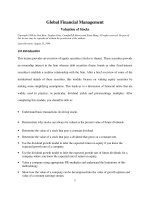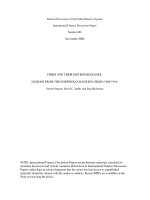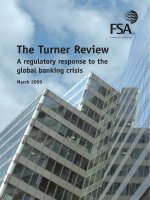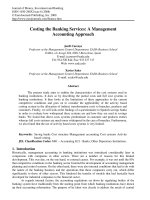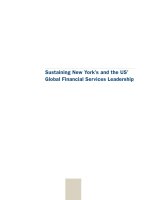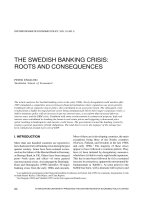Will COVID 19 pandemic trigger another global banking crisis - A lesson from previous global financial crisis
Bạn đang xem bản rút gọn của tài liệu. Xem và tải ngay bản đầy đủ của tài liệu tại đây (2.28 MB, 58 trang )
INDIVIDUAL ASSESSMENT
SEMESTER 1, 2020
Will COVID 19 pandemic trigger another global
banking crisis?
A lesson from previous global financial crisis
Student’s name …………….
Student’s ID ………………
Course ………………
Group number ………………….
Lecturer’s name ………………
, ........... 2020
Contents
CHAPTER ONE: INTRODUCTION
1.1. INTRODUCTION
From the beginning of 2020 to the present time, the Covid - 19 catastrophe is
taking place globally and particularly seriously in many countries, causing negative
impacts on the global economic and social situation. A World Bank study had
forecasted that income per capita just was expected to fall by 3.6%, while at the
same time pushing millions into poverty and unemployment in 2020. Furthermore,
the global economic value would witness a severe deterioration of 5.2% due to the
quick and heavy shock of the COVID-19 disaster; and measures of nations and
common economic sectors closing their economies to prevent the spread of the
COVID-19 disaster (Worldbank, 2020). In June alone, the world financial markets
suffered a huge loss of up to Rs 56.22 trillion (ETBFSI, 2020). The psychology of
economic sectors is seriously affected when the revenue source plummets,
especially in service, tourism and aviation industries.
Nations that the disaster had been most seriously and burdensome
associated with international trading activities, tourism, export – import and global
financing chains may be hardest hit. Although the level of impacts would vary among
nations and regions, all developing and emerging economies got hurt; furthermore,
those injuries were even more severe due to external shocks and no sign of
stopping.
Therefore, the operation of commercial banking systems is one of the most
seriously affected areas. There had been many opinions that this can be considered
as a new economic recession since the 2008 crisis stemming from the real estate
industry. This research was conducted to consider whether this disaster may raise
another global financial crisis or not based on the previous financial crises.
1.2. AIMS AND OBJECTIVES OF THE RESEARCH
-
This research described the effects and devastation of the epidemic on the
global economy, focusing on analysing the impacts on the international financial
banking system.
-
The research also fully analysed the prospects for the recovery of the
international banking market in general, and the development opportunities from that
recovery.
-
The study also investigated the depth and breadth of the global recession
storm impacting on the global financial system. The new global economic downturn
was the first since 1870 that originated from a pandemic; leading national
policymakers had to consider implementing additional powerful interventions, rather
than letting the economy recover itself after the recession through bailout packages
and fiscal policies.
-
The study assessed the long-term effects of the recession on the prospects
for long-term economic development, a serious decline in human resources and the
fissure of trade and supply links by focusing on three factor groups: black swan,
macroeconomic and banking factors.
-
Finally, the study offers solutions to promote the recovery and development of
the global economy based on the strength of the international banking system;
including scientific and technological advances in digital connectivity, e-financial
service packages, as well as recommendations for appropriate business policies and
decisions.
1.3. METHODOLOGY AND DATA
The main methodologies were conducted based on both qualitative research
while data resources were from economic reports and research papers from reliable
sources. Qualitative research: via case studies and practical observations that
financial institutions and countries performed policies to prevent an increase in
economic disaster; simultaneously analysing the developments and situations that
financial institutions have applied to recover from previous economic recessions.
1.4. STRUCTURAL SUMMARY OF THE DISSERTATION
The research included five chapters. While the first chapter had introduced
the aims – objectives, methodology and data resources of the research. The second
chapter focused on previous research documents assessing the impacts of the
disaster to the global economies and international banking sectors; and the ways to
respond to the disaster; then summary findings and critical review of those research
documents. The third chapter made a description of methodology (qualitative
method) and data resources of the research. From those methodology and data, the
research carried out analysis of economic indicators and qualitative data in the next
chapter. The final chapter summarizes the findings and recommendations of this
research, also pointing to the limitations and suggestions for the further research.
CHAPTER TWO: LITERATURE REVIEW
2.1 INTRODUCTION
The objective of this chapter is to synthesize theoretical reviews related to the
effects that the Covid-19 pandemic has caused to the banking industry in general
through research articles, reports, etc. In addition, the author also tended to analyse
and evaluate the content of previous studies on this issue, thereby forming a
framework and theoretical foundation to analyze the impact of Covid-19 to the
banking crisis in a specific context of Bloomberg.
In this chapter, there are three main parts including the introduction part, literature
review part and the conclusion part.
First, the parts of introduction will describe the purpose of literature review for
the entire study. In addition, this introduction part will cover the main content of each
section in this chapter, what issues the sections will deal with.
The second part of this chapter consists of main theories from literature that
will be used for analysis. This part is considered as the most important part of this
chapter because it deals with the whole theory from previous relevant studies, which
includes analysing from the situation of bank crisis due to the pandemic, the
problems that firms in banking industry have faced during the epidemic as well as
the solutions that they have come up with. Then, the author came to some personal
evaluations about these measures that were really effective or not.
The third part is the conclusion for the chapter. In this section, the author will
conclude through summarizing all literature, analysis. Moreover, achievements about
theory and framework were also displayed in this part, which will be used to apply for
analysis into specific contexts of the study.
2.2 LITERATURE REVIEW
2.2.1 Lessons from previous financial crises
“The Great Depression of 1929-1933 and 2007-2009? Parallels,
Differences and Policy Lessons” of Peter Eigner and Thomas S. Umlauft, 2015
These articles made a comparison of the causes and developments of two
major world financial crises, the Great Depression from 1929 to 1933 and the global
financial crisis in the 2007-2009 period. After that, the articles gave many lessons
related to financial system instability (real estate bubbles, subprime debt, economic
inequality problems, financial products causing systematic risks). These two global
financial crises were the worst since World War I. In both crises, the US banking
system has always played a key role in letting the crisis spread around the globe
when the banking system is mis-constructed and loosely managed to cause chaos.
finance increase.
While during the Great Depression, the US’s nominal gross domestic product
fell 29%, pricing level also fell 25%, unemployment rate stretched out more 20%,
approximately 9,000 bankers stopped common operations. In the 2008 crisis, the
global GDP in 2009 had the strongest drop in the past 60 years. At the same time,
there was a great decline in economic resources from other countries until now, like
Brexit, European government debts. The intervention of governments of the
countries is the main difference between the two crises. During the Great
Depression, the governments became more passive when it came to policy to
prevent crises developing. However, the role of the government in the economic
recovery in the 2008 crisis became more pronounced.
Finally, Peter Eigner and Thomas S. Umlauft pointed out some lessons from
those crises:
-
Real estate bubbles leading to a series of defaults, and then bank run
-
A loose legal framework that includes regulations on risk management
and equity-debt structure
-
Banking institutions had been granted too much power than allowed
leading to bad decisions
-
Legal intervention was needed to prevent the crisis spreading
However, the 2020 recession bore different characteristics from the two
previous great crises. The aforementioned lessons whether happen or not happen in
the immediate recession will be the focus of this research.
COVID-19 and non-performing loans: Lessons from past crises (Anil Ari,
Sophia Chen, Lev Ratnovsk, 2020) is a fairly detailed research on the problem of
solving bad debts from the banking crisis. COVID-19 followed the global economic
crisis. This leads to an increase in NPL. The sustainability of bank reporting is
reduced, the economic recovery is stagnant, and bank credit is significantly affected
by high debt (Aiyar et al. 2015, Kalemli-Ozcan et al. 2015). It can be seen that high
debt is one of the typical characteristics when the bank is in crisis and this problem is
studied a lot. This paper has been collecting data on banking crises since 1990.
Economists say this is a crisis that has caused large public debt, which has
led to an increase in many bad debts, and the problem of resolving bad debts will be
even more difficult. First of all, the article shows the status of NPL. Normally, bad
debt accounts for 20% of loans, but in many cases, the ratio will vary in countries
(sometimes up to 50% in developing countries). The probability of a bank avoiding
bad debt is high below 0.25%. The crisis has left a lot of consequences, the bad debt
ratio often increases sharply by 3.4 times, and even up to 10 times. Thus, the NPL is
increasingly high in the case of a crisis bank. Next is solving the bad debt after covi.
19. Solving the bad debt is always a difficult problem for economists, but it is
necessary to help the economy recover.The article shows some useful measures
such as:Reassessment of financial statements to review capital structure.Divide
assets into 2 types of good and bad assets. This will make the bank's financial
problem more transparent, giving the bank many loan opportunities.
In summary, the paper summarizes the measures that can solve bad debts. If
the recession is short-term, the reason may be because the company is illiquid.
Besides, the report also compares the solution of NPL in 2020 compared with 2008.
In 2020, the public debt ratio will increase, in addition, the slow economic recovery
rate after the epidemic will make the bad debt ratio. higher. Thus, the introduction of
policies to resolve bad debts is the situation that needs to be resolved as soon as
possible to avoid causing a crisis for the economy.
Through assessment, we can see that this article gives quite detailed
information about the status as well as solutions for the NPL. The article has many
models and tables to compare the fluctuations in bank debt before and after the
pandemic. That article is really necessary for this research article, because NPL is
one of the most fundamental features for the banking crisis.
2.2.2 How banking system over the world responded to the impacts of
COVID 19
“Banking system resilience in the time of COVID-19” of McKensey.
In July 2020, McKensey - a global financial consulting company - released a
description report about the ways banking systems over the world responded to the
impacts of the COVID 19 disaster based on capital cushions. First, the report
conducted a review of the 2008 financial crisis, which was triggered by a direct shock
from the banking industry; meanwhile, the current shock originated from a world
pandemic and the banking system just was an affected object. However, the banking
system plays an important role in the process of supporting economic recovery
through supplying many loans to organizations affected by the disease.
Unlike the financial crisis in 2008, the world banking system entered the
global economic recession in 2020 by the pandemic with a more dominant position.
By applying Basel III - a comprehensive standard set of reform measures built to
improve regulations, supervision process and risk management of the banking
sector, Europe’s CET1 ratios were 13%, this number in the UK reached 14% while
12% was in the US. As a result, the global banking system could absorb $100 bil to
$400 bil loss in CET1 and be ready to decrease CET1 ratios to 6 – 8%. Furthermore,
banks all over the world can continue to resist the expansion of the global economic
recession based on a capital conservation buffer with the value of 2.5% total risk
weighted assets. After that, McKensey had built scenarios for resilience to the world
economy after the pandemic:
(Resource: McKensey)
In which, there are three most likely scenarios: the global economy can
recover successfully by 2023 compared with before the time of the outbreak based
on scenario A1; while scenario A3 made the forecast in 2021, scenario B2 gave a
negative assessment of the effectiveness of public health.
McKensey forecasted that capital reserves of many banks in the US will get
the lowest reduction in 2021 if the pandemic is successfully controlled; while banks
in the EU will reach the lowest in the 2022-2023 period. In the worst case, CET1 of
almost all banks may be lowest at 5.5%. In each zone, banking managers and
government agencies must know their position to make the right decisions because
raising additional capital will be impossible.
Finally, McKensey suggested government intervention in the banking system.
The government should put in place policies to support socially vulnerable people,
small and medium companies, and other special sectors such as sustainable energy
industry, medical services and even aviation via national and international banking
systems.
Report of SRS "COVID-19 and the Banking Industry: Risks and Policy
Responses", 2020 only produced a report analyzing the impact of the global
pandemic on the world economy, and specifically on the banking industry. In fact, the
bank operates on the savings of individuals and households and uses it as a fund for
its operations. This paper has studied quite sufficiently and in detail about each
aspect that banks are affected. This report has studied quite adequately and in detail
about each aspect that banks are affected. Specifically, the bank's items threatened
by pandemic are as follows: bank debt, capital structure, the influence of the items in
the financial statements to consider the level of losses in the operational situation
and financial activities of the bank.
In addition, the report also addresses the issue of relief from the Federal
Reserve, FDIC in order to minimize the risk for banks. The report uses year-to-year
data, as well as a table to compare figures to identify the financial situation of the
bank. As such, this paper explores Covid 19's impacts on the banking industry, as
well as current solutions to help the banking industry overcome this global crisis.
The activities of the bank are closely related to all changes of organizations
and individuals in society. Therefore, with the impact of the COVID-19 pandemic,
there will be a significant impact on the banking industry. In particular, it can be seen
that out of the 11 largest banks in the world, China accounts for 4 banks. Thus,
COVID-19 has a great pressure on China's economy, or more clearly the banking
industry. Therefore, Oliver Wyman, 2020 published the report "COVID-19 and
financing services in China" to address the impact of service industries by this
epidemic.
First of all, the report summarizes the table before and after the epidemic. The
5 service sectors in this report are: Banks, securities firms, insurance companies,
asset managers and wealth managers. Before Covid, for the banking sector, the
growth rate of assets and profits tended to decrease, but remained above 5%. But in
the time of COVID, accumulated bad debts increased, the bank lost the ability to
manage bad debts. After that, the report offers solutions to minimize bad debts, as
well as help banks strictly manage NPL. For example, stimulating consumers to sign
up for health insurance packages, thereby making the bank gain a considerable
profit. Bank of China needs to reconsider the business process in the period of
diversifying production and product sourcing.
Strict management of non-performing loans and maintenance of long-term
credit are essential for banks to anticipate an increase in non-performing loans.
However, COVID also brings new opportunities for the service industry, such as an
increase in online services (the sales of mutual funds increased by 400% in the first
2 weeks of February). Then, are the solution models for banks in this outbreak. That
is, health care is closely linked with banks to minimize risks, as well as increase
product productivity. After proposing that strategy, the report also announced the
bank's performance on a business scale.
In summary, with the introduction of live data and specific facts, the research
has shown the risks posed by COVID to the banking industry. Besides, it also
presents opportunities and challenges for the banking industry now, and finally the
solution. This paper, mainly focusing on solutions for banking services during the
COVID season, does not analyze the impact of COVID on aspects of the banking
industry. Therefore, it is difficult for readers to imagine the impact of COVID on the
banking crisis. It is even more unclear what the government's policy has done for this
service industry.
Last but not least, the “Effects of Covid-19 on the banking sector: the
market’s assessment (Iñaki Aldasoro, Ingo Fender, Bryan Hardy and Nikola
Tarashev, 2020)” has synthesised fully the data as well as assessment of banking
industry during the pandemic of Covid-19 and its effects. Indeed, the banking
industry has been hit harder than other sectors because the Covid-19 pandemic has
been spreading unsettlingly around the world. This has led the financial market face
to a tailspin. According to the BIS Bulletin report, an assessment about performance
of banks was examined and it mainly focused on the prices of stock, credit default
swap (CDS), spreads of bond as well as rating of credit.
During the first seven weeks of the early year, the market was still stable
generally but almost changed quickly after that. Till the middle of February, the
market is getting more stressful, the prices of stock tend to fall in lockstep in the
whole market. However, when the stock market began emerging the onset of a
generalised sell-off on 5th of March, it has led banks to participate in the worst
performers (figure…).
Consequently, by the time of the April’s last week, the stock’s prices of banks
decreased much deeper than other fields which are the hardest-hit of the economics.
(Source: Datastream; FitchRating; JPMorgan Chase; BIS Bulletin)
When the prices of stock fell down, the ratios of price-to book did also, which
was much under than one for banks in Europe and the USA on average. Banking
sector has suffered more and more due to both relative others and previous crises’
comparison. To be more details, although it has been recovered partially in recent
years, the stock’s price declines equally to the Lehman Brothers’ collapse period in
2008 (figure…). The spreads of CDS experienced the same performance. By this
development, the outlook from the rating of the bank's long-term began deteriorating
and displayed the concern about Covid-19’s impact on earnings of banks.
While conditions of the market were deteriorated, costs of funding indicators
in banks grew significantly. In the early of March, indices of bank’s bond spreads
enlarged in various maturities and currencies substantially. Nevertheless, this spread
was narrowed partly in the first week of April by following the political decision of the
Federal Reserve and the ECB (figure…).
Source: Markit iBoxx; BIS Bulletin
According to the characteristics of banks before the pandemic of Covid-19,
patterns of differentiation in the stock market were more pronounced than after
selling off initially (figure…). Especially, banks that have good capital recovered
much better than the poor one. Therefore, banks were rewarded by markets
because of their robustness. In terms of CDS markets, they have responded
remarkably during the period of pre-pandemic, which rely on short-term funding. In
more profitable banks, the CDS spreads fell more than before the crisis, which was
measured by “return on assets” (ROA).
Source: Blomberg; Datastream; Fitch; Markit; BIS Bulletin
In Europe, banks have been plagued with low profit for a long time. In which,
the ROA of them notably hovered below than in other jurisdictions (figure…)
(Bogdanova et al (2018)). In general, with banks that gained less profit, they were
more likely to reduce their own outlook to suggest the scope going forward for
downgrades outright.
It is not differentiating among banks in the stock market regarding their ratings
before the Covid-19 (figure…). Investors in equity tend to concern more and more
about the overview of deterioration of performance outlook in banks, which was not
detailed to any rating of credit. As a result, the prices of stock broadly moved like the
categories’ ratings in the middle of February. In contrast, the CDS market has
penalised strictly the low rating banks. Banks that had the BBB+ rating or lower,
particularly in ratings of high yield, witnessed their spreads of CDS have the
strongest increase during the initial turmoil.
Source: Bloomberg; Datastream; FitchRatings; Markit; BIS Bulletin
2.2.3. Global governments initiatives to date to support the banking industry
During the period when the Covid-19 epidemic drove the economy over, the
banking industry was also severely affected. A variety of policy measures that have
been taken in wide-range by national authorities to support sectors in the economy
and try to maintain the adequate liquidity in the system of finance.
Those policies consist of supporting debt moratoria and fiscal in large-scale,
guaranteeing credit, providing to affected sectors and borrowers with much-needed
relief, which includes households and SMEs in particular (World Bank Group, 2020).
Besides, in order to solve serious strains in the main funding markets, the liquidity
and monetary stimulus have been restored by the policy makers. By these policies,
the resilience and lending of the financial sector have been supported significantly.
In addition, guidance to support national authorities have been issued by the
Standard-Setting Bodies (SSBs) with their efforts to supply sound and measures with
well-coordinated policy. There are several objectives in this guidance including (i)
national jurisdiction has taken supporting measures to combat the Covid-19
pandemic, especially in the careful design of general debt moratoria’s form; (ii)
existing flexibility within standard of globe consist of buffers will be made use by
encouraging the international financial community; (iii) additional operational capacity
will be provided for national authorities as well as financial institutes to response to
the sudden priorities of financial stability and (iv) protecting consumer will be
enhanced transparently. In general, all the SSBs’ activities aim to provide a steady
and coordinated response to support authorities, financial institutes as well as the
economy to preserve the financial stability then ensure that the market can continue
being its functions.
Overview of Statements and Guidance Provided by Standard-Setting
Bodies in Response to the COVID-19 Pandemic
Source: World Bank Group, 2020
2.3 CONCLUSION
The Coronavirus epidemic can cause banks' bad debt to increase when
businesses and families are negatively affected. Credit demand may decline in the
first two quarters of the year. With the banking system, the Covid-19 epidemic is
reported to affect two important aspects.
The first is that the demand for credit is reduced due to the lower demand for
credit of businesses and households, leading to difficulties in production and
business activities. Regarding the impacts, it can be seen that the consequences of
bad debts bring extremely difficult solutions. It has a negative impact on the
economy in general and the operation of commercial banks and customers in
particular. For the economy: Bad debt will increase the pressure on inflation,
restraining production and business activities. The biggest danger is that if the bad
debt with a large credit line can lead to a crisis of the banking and financial system
and the whole economy.For the system of commercial banks: Bad debt will make
commercial banks use capital inefficiently, reduce profits, bear cash flow risks,
reduce solvency for bank payments. From early 2020 to now, the Covid pandemic 19 taking place worldwide has caused serious impacts on the economy - society in
general, the operation of businesses and the commercial banking system in
particular.
Based on past studies, we have found out how the bank is affected in the
COVID-19 epidemic. Typically, it is the NPL issue - a prominent issue that the bank
will encounter in a financial crisis. Besides, it can be seen that the recovery after
COVID-19 is affected by the capital structure of banking, as well as net returns.
Thereby are the solutions of the government, the bank to minimize risks to the
minimum, ways to reduce bad debts, .. to help the economy recover after the
pandemic.
However, most reports are made based on the assumption that the world will
be able to successfully control the pandemic by 2020 and begin the process of
economic recovery by 2021.
CHAPTER THREE: METHODOLOGY AND DATA
3.1 INTRODUCTION
The purpose of the chapter is intended to clarify the chosen methodology and
data. As stated earlier, this dissertation is intended to evaluate the impact of Covid19 on whether a new global banking crisis may be triggered through a process of
studying the factors that cause these crises. Before that, it consists of three main
groups of elements: Macroeconomic factors, banking market factors and black swan
effect. For each type of factor groups, the study applies different methodologies and
databases. The main sources of information and data are extracted from reliable
sources. Up to now, the Covid-19 epidemic is still raging around the world and the
economic forecasting process generally met many difficulties. In addition, the
research also conducted some objective assessments and analysis of the global
banking system situation before and after the epidemic, lessons from previous
financial banking system crises.
The banking system plays an important role in the circulation of capital
sources and the amount of money in an economy. The banking system consists of
many commercial banks, national banks and government agencies. The banking
system in each country is different from other countries, so the operation of the
global banking system is very complicated. There are many factors that affect the
health of the banking system in general.
There have been many models and methods built to ensure a strong banking
system that is strong enough to promote economic development. While this research
applies qualitative research methods. With macroeconomic factors, this research
applied to consider qualitative methods: analyzing macroeconomic policies used
mainly qualitative methods while analyzing macroeconomic indicators used mainly
qualitative methods. Banking market factors took advantage of qualitative methods
when focusing on analytical statistics. The last black swan theory concentrated on
qualitative methods when describing surprising, strong-impacting and inappropriately
interpreted events because Covid-19 might be considered as a black swan event.
This chapter included distinctive five parts. While the methodology of this
research was presented in part two that had talking about each methodology of each
factor group, the main participants were global macro-economic indicators, micro
banking system indicators and criteria for a black swan event. The next part showed
some key formulas used in this research to analyze data collected. The fourth part
made a description to collect data that served this research.
3.2 METHODOLOGY
3.2.1. The Black swan theory application
The Black swan theory in “The black swan the impact of the highly
improbable” book of Nassim Nicholas Taleb
The term black swan was developed by Nassim Nicholas Taleb, a successful
professor in the finance field, book writer, and merchant on Wall Street. He
elaborated on the black swan theory in his own book, in which the black swan effect
has three main characteristics:
- Beyond far from normal predictions, rarely happen
- There were dire consequences when it happened
- There were many warnings before that incident happened.
Since a black swan event was unpredictable due to very extreme rarity but
still has disastrous consequences, it is essential that people always consider black
swan events to be a possibility and should have built plans accordingly. The dot-com
bubble of 2001, the global economic crisis of 2008, the Swiss bank announced the
floating exchange rate of Swiss-France were particularly black swan events. "In this
world, anything can happen!".
The first purpose of the black swan theory was not to try to make forecasts of
unpredictable events in the future, but to build a solid framework to prevent and
minimize damage from negative events while increasing exploitation of other positive
events. Taleb believed that global banking systems and international commercial
companies are very vulnerable and attached with the dangers of unpredictable
losses from dangerous black swan events. In terms of business and qualitative
finance, in particular, Taleb was critical of the widespread usage of the normal
distribution model applied in the financial field (Taleb, Nassim Nicholas, 2010).
In order to extend the analysis process the black swan theory of Taleb, the
research used comparative methods. Following Pickvance (2005), a comparative
method was performed generally for explaining and detail understanding the causal
matters relevant to the characteristics of events or relationships often by a set of
explanatory variations or variables. There are so many ways to make a comparison
between two events (2008 crisis and 2020 depression), however the research
focused on variation-finding comparison. Comparative search method of variation
aims to build a set of criteria for the cause, character and intensity of the events by
analyzing the systematic differences between the events. The process of evolving an
event has its own way of functioning, as a result, the research tried to find a
connection between the most recent financial crisis and the recent crisis.
3.2.2. The banking crisis is caused by macroeconomic factors
There are many studies in the past that have shown that the macro economy
plays an important role in the financial crisis of banks. Ouarda Merrouche and Erlend
Nier, 2010 have successfully studied using qualitative method, regression function to
explain the formation of crisis. Thereby, in this study, the author has selected 3 main
macro factors that affect the analytical objectives. Specifically, there were 3 factors of
GDP, inflation rate and interest rate.The author has provided convincing evidence of
GDP based on the ratio of bank credit to GDP. Low GDP growth has a significant
relationship with banking risk. Because it can be seen that GDP directly affects the
capital inflow of any business, not just banks. The increased risk has been combined
with inflation and high nominal interest rates because a bank conversion is unlikely
to be possible. Stable inflation has been shown to exist in advanced economies,
which has led to expanded trade credit; and underdeveloped countries have
synonymous with poor commercial credit (Hume and Sentence, 2009).
In addition, in 1997, Asli Demirguc-Kunt used a multivariate logarithmic
economic model, the author pointed out that the probability of a crisis occurring is
proportional to the underdevelopment of the macro environment, especially during
the period of high inflation and low growth, in addition, the higher the actual interest
rate, the more the bank has paid attention to the liquidity issue.
Therefore, based on 2 studies by 2 authors, Ouarda Merrouche, Erlend Nier
and Asli Demirguc-Kunt, we can conclude that 3 macro factors are the cause of the
banking crisis: GDP, inflation rate, interest rate, Evans Agalega & Samuel Antwi,
2013 stated that lending interest rates have a large impact on GDP. This means that
GDP and interest rates are negatively correlated. Falling interest rates lead to
increased GDP, the interest rate increase leads to GDP decrease. Shariq ahmad
Bhat's study showed the model between them
Figure :
Source: Shariq ahmad Bhat's, 2016
3.2.3. Risk modeling
In many companies, especially in the banking industry, the securitisation,
rating of credit agencies as well as ineffective risk modeling are reformed. It seems
that there is a casual relationship among each other in underwriting standards and
corporate governance lapses.
For many years, risk modeling has been used prevalently in current industries
and they have made integral to businesses for example financial services and
energy. Recently, companies in both public and private sectors realized and started
adopting the simulations of risk models widely in order to address risks of strategy,
operations, compliance, geopolitics, etc. Models making has become more and more
practical because of wider available data and more analysis abilities; besides, the
environmental risks are also increasing that make building a risk modeling get more
valued.
Figure…: Basel III framework
Source: Compatibl, 2020
The international framework of a liquidity risk was introduced by the Basel III
for the first time, which could reflect the excessive liquidity risk experiences to take
serious flaws in managing the risk of liquidity of banks in running to crisis of finance
erupted in August of 2007 and linked to the negative external factors. Banks always
play significant roles in the provision of liquidity to them during normal as well as
crisis period. The reason is because of interaction among banks in their operations,
that is obviously necessary. The purpose of the Basel III framework after that is
protecting the stability of finance and sustainable promotion of economic growth. To
be more detailed, if the capital level is high, the financial crisis probability in the
future is small (Ulrich et al., 2011).

